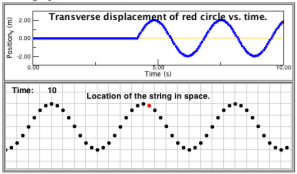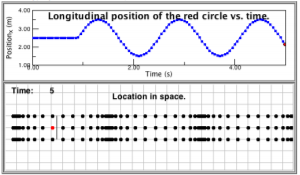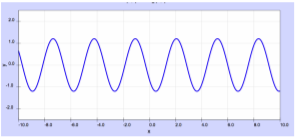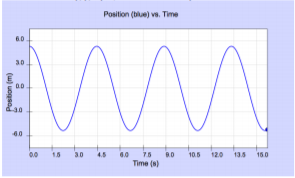4.4.2: Antenna Simulation
- Page ID
- 26164
In this simulation you see an oscillating electron in a sending antenna on the left. Because electrons have an electric field, an accelerating electron will create a wave in the electric field around it. Magnetic fields are created by moving charges so a magnetic wave is also formed by an accelerating charge. Only the y-component of the change in the electric field is shown (so an oscillation frequency of zero will show nothing, because there is only a constant electric field). The magnetic fields are not shown.
The simplest type of receiving antenna can be approximated by free charges (electrons) constrained by a metal wire. For a receiving antenna oriented in the y-direction, an oscillating field traveling in the \(x\)-direction will cause the charges in the receiver to oscillate in the y-direction with the same frequency as the wave (the charges cannot move in the \(x\)-direction because they are confined to the wire). This oscillating current can then be analyzed by electronic circuitry to extract the transmitted signal. A general rule of thumb is that for strongest reception, the receiving antenna should be roughly the same length as the wavelength of the wave it is trying to receive.
For simplicity this simulation has oscillating positive charges in the sending and receiving antennas. (Electrons feel a force in the opposite direction of the applied field.) Time is measured in microseconds (\(10^{-6}\text{ s}\)).
Simulation Questions:
- Run the simulation and describe what you see. Does the receiving antenna charge start oscillating immediately? Why or why not?
- Try different oscillation frequencies. How does the frequency of the sending charge compare with the frequency of oscillation of the charge in the receiving antenna?
- Use the step button to find the time lapse between when the source charge starts to oscillate and when the receiver starts oscillating. If the receiving antenna is \(1.6\times 10^{3}\text{ m}\) away, what is the speed of the wave?
- Repeat the previous exercise with different oscillation frequencies. Does changing the oscillation frequency change the speed the wave travels in the \(x\)-direction? What does change if the oscillation speed changes? (Hint: Recall that \(v=\lambda f\) where \(v\) is the speed of the wave.)
- What do you notice about the amplitude of the wave as it travels away from the sending antenna? Explain.
Chapter Five Summary
For transverse waves the motion is up and down while the wave moves forward. Examples include water waves, electromagnetic waves, and earthquake S-waves. In longitudinal (compressional) waves the motion is back and forth in the same direction the wave travels. Sound waves and earthquake P-waves are examples. The same equations and behavior applies to all types of waves.
Questions on Wave Types:
\(f=1/T\qquad v=f\lambda\qquad v=\omega /k\qquad k=2\pi /\lambda\qquad \omega =2\pi f\qquad y(x,t)=A\cos (kx-\omega t+\phi )\)
- Give a definition of wavelength. In what units is wavelength measured?
- What is the difference between wavelength and period? How do you measure each?
- Give a definition and example of a transverse wave, a longitudinal wave and a torsional wave.
- Suppose you have a slinky stretched between you and another person. Describe what you would do to your end to make
- a transverse wave
- a longitudinal wave
- a torsional wave.
- In the following graph, determine the period and wavelength of the wave on the string. Each block on the lower graph is one meter, time is in seconds as shown on the upper graph.

Figure \(\PageIndex{1}\)
- In the following graph, determine the period and wavelength of the wave on the string. Each block on the lower graph is one meter, time is in seconds as shown on the upper graph.

Figure \(\PageIndex{2}\)
- Why are longitudinal waves sometimes called compressional waves?
- What are compressions and rarefactions in sound waves?
- How is simple harmonic motion (a mass on a spring) connected to wave motion for transverse waves (Hint: Look at the transverse wave simulation.)?
- How is simple harmonic motion (a mass on a spring) connected to wave motion for longitudinal waves?
- What are S-waves and P-waves?
- Describe the major types of surface earthquake waves.
- Is a water wave longitudinal, transverse or both? Explain.
- Find the wavelength of a \(20\text{ Hz}\) sound wave (about the lowest note humans can hear) and the wavelength of a \(20,000\text{ Hz}\) sound wave (about the highest note humans can hear). Assume the speed of sound is \(343\text{ m/s}\).
- What is the connection between simple harmonic motion and the points on a string when the string has a wave traveling on it?
- In the following graph, determine the wavelength of the wave. X is measured in centimeters.

Figure \(\PageIndex{3}\)
- In the graph above, what is the amplitude of the wave?
- In the following graph, determine the period of the wave.

Figure \(\PageIndex{4}\)
- For the graph above, what is the frequency of the wave?
- For the preceding graph, what is the amplitude of the wave?
- What is the angular frequency, \(\omega\), for a \(20\text{ Hz}\) sound wave? (Hint: See top of page).
- What is the wave vector, \(k\), for a \(4.0\) meter sound wave?
- What are electromagnetic waves? Give some examples.
- What is the difference between sound waves and radio signals?
- Why can we see visible light but not other types of electromagnetic waves?
- What is the difference between a gamma-ray and visible light?
- What is the difference between ionizing radiation and non-ionizing radiation?
- Why can’t cell phone signals cause cancer but x-rays can (they both electromagnetic waves)?
- What is the wavelength of a radio signal of \(89.3\text{ MHz}\), given than \(\text{M} =\) Mega \(= 106\) and the speed of radio signals are the same as light (\(3.0\times 10^{8}\text{ m/s}\))?
- Calculate the frequency of your favorite color. Hint: Nanometers \(=\text{ nm} = 10^{-9}\text{ m}\).


